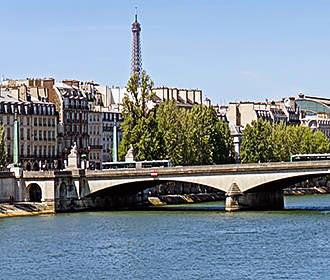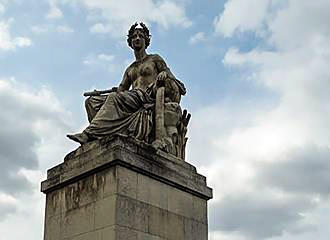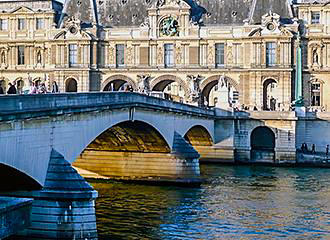Paris Pont du Carrousel History 1800s
The first bridge that was located at this point was designed by the architect Antoine-Remy Polonceau in 1830 and was a major technical feat of engineering for its time, due to its lightweight structure utilising wood and cast iron.
However, the idea of this type of arched bridge instead of the more popular suspension bridge concept that was now being utilised, came with much opposition, and Antoine-Remy Polonceau fought very hard to have his design accepted, and even financed the initial foundation work, which started in 1831.
The initial structure comprised three main arches over the River Seine and these were comprised of five composite wood and cast iron arches that supported the wooden deck, which was a daring and unusual design, although rather fragile compared to many other bridges.
Yet the construction continued with the name chosen of Pont des Saints-Peres, which was named after the street that the bridge met at the river, and eventually the bridge was completed in 1834.
But when it was inaugurated by King Louis Philippe in the same year, he gave it the name of the Paris Pont du Carrousel, due to its proximity with the Arc de Triomphe du Carrousel within the Tuileries Gardens.
A few years later, in 1847 in fact, the Paris Pont du carrousel was decorated by four different statue groups that were positioned at each of its corners. And designed by the sculptor Louis Petitot, these allegory stone statues represent Industry, Abundance, The City of Paris and the River Seine.
However, by 1883, the Pont du Carrousel ended up having to be closed for several months in order that beams and cross members could be replaced, plus at this stage it was suggested that the wooden deck was also replaced by beaten iron.
Paris Pont du Carrousel History 1900s
Yet the actual change from wooden decking on the Paris Pont du Carrousel to a beaten iron deck did not happen until 1906, and it was at this time the Paris Council also decided to change the name of this bridge over the River Seine back to the original of Pont des Saints-Peres.
Although, during the work that was undertaken, the four statues by Louis Petitot had to be moved so as to make modifications to the entrances to the Pont des Saints-Peres, and these were not actually put back in place on the new pedestals they had built until 1908.
And although these changes made the bridge slightly more sturdy with easier access, it was still very flexible and would shake and move quite scarily, especially with the increased amount of traffic over time. So by 1930 the Pont des Saints-Peres was deemed too narrow and dangerous for the continued growth of traffic, plus it was considered too low for the river traffic as well, and therefore the decision was taken to completely rebuild the bridge.
Work started on a new bridge in the July of 1935 after the plans of the architects and engineers Malet and Lang had been approved.
However, it was to be renamed back to the Paris Pont du Carrousel again, plus the decision was also taken to move the bridge a few metres downstream, so that it would line up completely with The Louvre Museum and the entrance where you will find the Arc de Triomphe du Carrousel.
Now the new Paris Pont du Carrousel bridge was constructed far wider than the original, and higher, yet it was not completed until the July of 1939 with the four allegorical stone statues in Paris being realigned as well. Yet at its completion, discussions about lighting the bridge came about, and many different projects were considered.
Eventually, an unusual design project by Raymond Subes was agreed upon, which would entail having pillars or obelisks put in place with a telescopic system that meant the lights could be raised up at nightfall. But constructed during World War II while Paris was under occupation, these were hidden in the abutments of the Paris Pont du Carrousel awaiting the end of the war.
And these bronze lighting mechanisms were brought out of hiding in 1946 and erected in place, however, due to their fragility, unfortunately they were deemed unsuitable for daily use, but the pillars on the Paris Pont du Carrousel can still be seen today.


